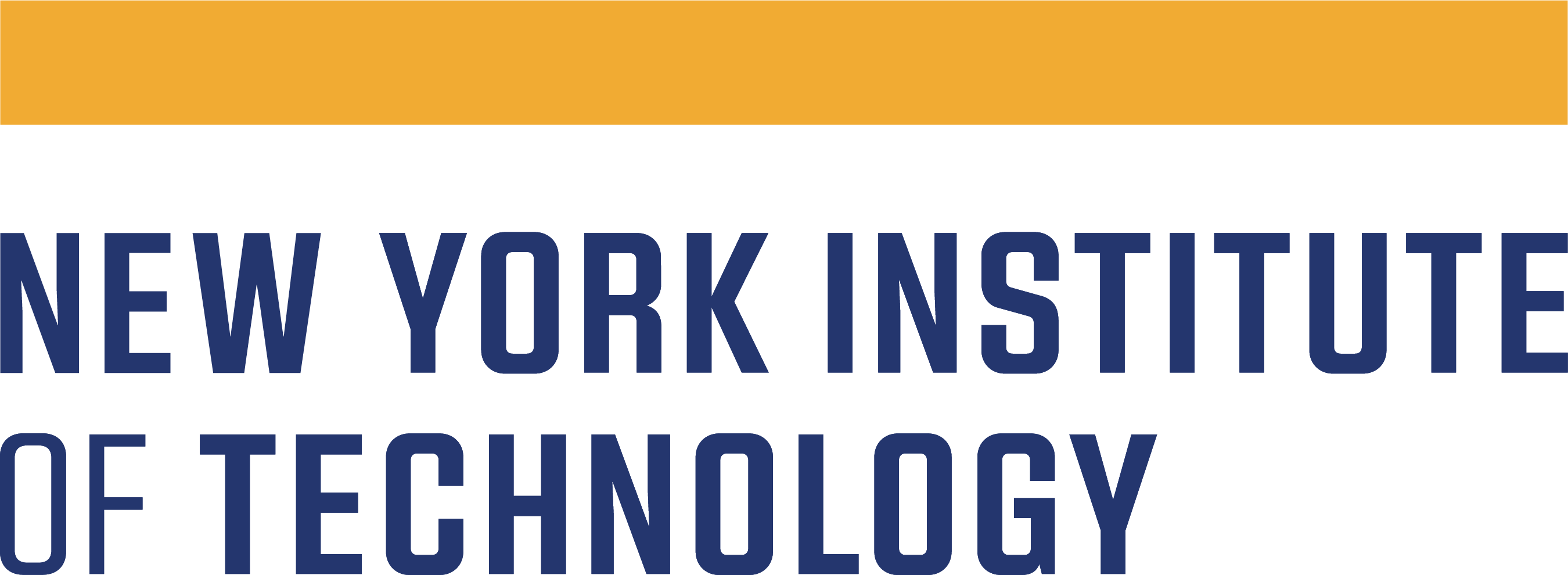When COVID-19 Forced Him to Teach Online,
This New York Tech Professor Got Creative
How a Flipped Classroom, Journal Clubs, and “Ad-Lib” Conversations Kept Students Engaged

In January 2020, at the beginning of the spring semester at New York Institute of Technology, Assistant Professor of Biological and Chemical Sciences Bryan Gibb, Ph.D., was already talking with his microbiology students about the novel coronavirus. As Gibb discussed events unfolding in China and Europe, on cruise ships, and then in the United States, he realized the COVID-19 outbreak was helping his undergrads understand the relevance of microbiology. “In the midst of a pandemic,” recalls Gibb, “answering the question, ‘Why would I want to learn this stuff?’ was easy.”
That may have been the last time anything felt easy. By March, New York Tech’s faculty and 9,000 students had been forced to pivot 1,500 course sections to remote learning. Classrooms, labs, and facilities at the university’s Long Island and New York City campuses as well as locations in Jonesboro, Arkansas and Vancouver, Canada suddenly emptied.
“There was so much to worry about,” says Gibb, who has taught at New York Tech’s College of Arts & Sciences since 2015. “I had one student who was scared because her roommate’s mother was in the ICU with COVID-19. She was worried about her roommate, as well as her own health and safety. Because we’re in New York, many of our students know people who have died. We’ve heard some very rough stories from our students.”
On top of helping anxious students, professors faced an additional challenge: quickly figuring out how to become adept at teaching online.
Tips to Help You Embrace
Remote Teaching and Learning
In a series of videos, Gibb and his colleagues explain how they shifted to online education. Gibb also shares five tools to help master remote teaching:
- A robust LMS provides a centralized place for uploading and offering all manner of asynchronous learning. New York Tech has long used Blackboard, but will soon be moving to Canvas.
- A digital media application like VoiceThread lets students interact on their own time, at their own pace, with materials such as slide presentations and video recordings. “Students can pause anywhere and embed a question, so it’s easy to see where they are in the content and get them the answer they need,” says Gibb.
- Zoom is more than a videoconferencing technology. “Set up the call so students are required to register,” says Gibb. “That gives you a record of attendance and helps with grading. For large classes, use the breakout rooms.”
- Camtasia is a for-purchase screen recording- and video-editing software that makes it easy to create high-quality lectures and presentations with smooth transitions and PowerPoint integration.
- A quality microphone doesn’t need to break the bank. (Check the reviews before you invest.) Gibb uses the Snowball by Blue.
In January 2020, at the beginning of the spring semester at New York Institute of Technology, Assistant Professor of Biological and Chemical Sciences Bryan Gibb, Ph.D., was already talking with his microbiology students about the novel coronavirus. As Gibb discussed events unfolding in China and Europe, on cruise ships, and then in the United States, he realized the COVID-19 outbreak was helping his undergrads understand the relevance of microbiology. “In the midst of a pandemic,” recalls Gibb, “answering the question, ‘Why would I want to learn this stuff?’ was easy.”
That may have been the last time anything felt easy. By March, New York Tech’s faculty and 9,000 students had been forced to pivot 1,500 course sections to remote learning. Classrooms, labs, and facilities at the university’s Long Island and New York City campuses as well as locations in Jonesboro, Arkansas and Vancouver, Canada suddenly emptied.
“There was so much to worry about,” says Gibb, who has taught at New York Tech’s College of Arts & Sciences since 2015. “I had one student who was scared because her roommate’s mother was in the ICU with COVID-19. She was worried about her roommate, as well as her own health and safety. Because we’re in New York, many of our students know people who have died. We’ve heard some very rough stories from our students.”
On top of helping anxious students, professors faced an additional challenge: quickly figuring out how to become adept at teaching online.
Tips to Help You Embrace Remote Teaching and Learning
In a series of videos, Gibb and his colleagues explain how they shifted to online education. Gibb also shares five tools to help master remote teaching:
- A robust LMS provides a centralized place for uploading and offering all manner of asynchronous learning. New York Tech has long used Blackboard, but will soon be moving to Canvas.
- A digital media application like VoiceThread lets students interact on their own time, at their own pace, with materials such as slide presentations and video recordings. “Students can pause anywhere and embed a question, so it’s easy to see where they are in the content and get them the answer they need,” says Gibb.
- Zoom is more than a videoconferencing technology. “Set up the call so students are required to register,” says Gibb. “That gives you a record of attendance and helps with grading. For large classes, use the breakout rooms.”
- Camtasia is a for-purchase screen recording- and video-editing software that makes it easy to create high-quality lectures and presentations with smooth transitions and PowerPoint integration.
- A quality microphone doesn’t need to break the bank. (Check the reviews before you invest.) Gibb uses the Snowball by Blue.
Putting students—and research—first
Although he’d never navigated anything like this before, Gibb immediately focused on how to support his undergraduate students during the crisis. His response was true to form, since generosity and compassion have always been fundamental to his teaching. In fact, Gibb, like many of his New York Tech colleagues, was drawn to the university precisely because it prioritizes practical education and research opportunities for undergraduates.
“A few years ago, there was a shift at New York Tech toward recruiting people who do research,” Gibb explains. “I joined the Department of Biological and Chemical Sciences after my postdoc at Columbia University. We believe that doing research with undergrads exposes them to experiences and ideas that might transform their career paths. I wanted to be part of that transformation.”
Prior to the pandemic, Gibb was teaching two lecture-based courses of up to 60 students each semester, as well as leading smaller groups of student researchers in the lab each week. Although he taught traditional in-person classes,” he also used online tools to enhance the classroom experience. He explains: “When I first decided to teach undergrads, I read a lot about ‘active learning’ approaches. I wanted to take advantage of tools that could improve engagement and learning.”
With that goal in mind, Gibb turned to New York Tech’s Center for Teaching and Learning (CTL). Gibb says he’s “in awe of the wizards” at the CTL who guided him through the Learning Management System’s integrated platform for sharing and engaging with digital media, interacting asynchronously with content, and staying on top of grades, attendance, workflow, and more.
“You can do so much with this technology, and that’s what makes it complicated,” says Gibb. “The CTL has been a fantastic resource. They’re always finding new teaching modalities and tools, and then communicating with others who are exploring new ways to do things.”
Dr. Bryan Gibb, Assistant Professor, Biological & Chemical Sciences, demonstrates how he sets up exams and quizzes in Blackboard and uses VoiceThread for flipped-style lectures in order to maximize interaction in the Zoom classroom. Credit: New York Institute of Technology.
Engaging students during a crisis
Despite the inevitable scrambling following New York Tech’s pause of in-person learning, Gibb felt pretty prepared to shift to entirely remote teaching. In fact, he embraced the opportunity to get creative. In his lecture-style classes, for example, he utilized a flipped model of teaching: Gibb recorded his presentation and posted the video on VoiceThread. Then he required students to watch it during one of the dedicated class periods before attending the live Zoom class. That way, he could “ad-lib” real-time conversations online with students about everything from the lecture itself to the latest coronavirus developments.
Replacing the lab-based research courses was more challenging. Gibb and a lab technician spent a week running and recording every single lab so students could watch a visual demonstration of the research. Gibb provided data, measurements, pictures, and Excel tables and had students complete worksheets based on those scientific findings.
Another example of educational experimentation? Gibb and his colleague, Assistant Professor Navin Pokala, Ph.D., both started running “journal clubs” for students to read COVID-19-related journal articles and then discuss them in small groups. Others got credit for attending virtual symposia and writing up reports based on the scientists’ presentations. Another team of undergrads researched and wrote an evidence-based report in response to misinformation about hydroxychloroquine as a treatment for the virus.
“Our faculty worked hard to promote what other colleagues were doing, and rescue a broken semester,” says Gibb. “We were scrambling, but in a good way.” In a nod to the collegial culture of the university, he adds that some faculty who were less familiar with online teaching sought support from those who knew their way around a Zoom call. The CTL also created a page of video “tours” to help faculty share their online education insights and ideas.
New York Tech at a Glance
- 9,000 students worldwide
- 900 faculty (full-time and part-time)
- 90 undergraduate, graduate, and professional degree programs in 50+ fields of study
- 12:1 student-to-faculty ratio
- 6 schools and colleges: Architecture & Design, Arts & Sciences, Engineering & Computing Sciences, Health Professions, Management, Osteopathic Medicine
Preparing for an uncertain fall
Since the spring semester wrapped up in May, Gibb has been teaching a summer microbiology course. The small class size means he’s been able to further experiment with new teaching approaches, like foregoing exams and trying to create cheat-proof assignments. Most of all, he’s hoping the time he invests in honing his online teaching skills and tools will pay off this fall.
Still, planning ahead is tricky. While the current approach is to plan for both face-to-face and remote learning, that has its own set of challenges. “Obviously, focusing on a single teaching modality is better than trying to offer two completely separate experiences at the same time,” says Gibb.
“Given what we now know about the coronavirus, whatever we do, it will be hard,” he adds. “But I know the New York Tech faculty is committed to putting out the best education product possible.”
This content was paid for by New York Institute of Technology and produced by Inside Higher Ed's sponsored content team. The editorial staff of Inside Higher Ed had no role in its preparation.


